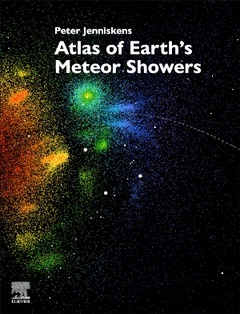Atlas of Earth's Meteor Showers
Auteur : Jenniskens Peter

The International Astronomical Union formalized the naming of meteor showers in 2006. Each newly discovered shower now is assigned a unique and officially recognized name, number, and 3-letter code. Close to a thousand possible meteor showers have since been reported, over a hundred in the cause of writing this book.
Atlas of Earth's Meteor Showers takes stock of all reported detections by going back to the combined video and radar data in hand at the end of 2021, in order to weed out duplicates and false detections. Maps were created that show the direction of motion of meteors (their radiant) during 5-day and 10-day intervals throughout the year. All 500+ showers recognized are briefly described from their radiant, speed, and orbital elements, and the meteoroid mass distribution index was calculated. Physical properties of the meteoroids were derived from their beginning, peak and end height, from their deceleration in Earth's atmosphere, and from spectroscopic information. Candidate parent bodies are mentioned and the age of the stream was calculated from the dispersions in orbital elements and from the meteor magnitude distribution index. A brief history is given of the shower's discovery, of when features were first recognized, and of results from dynamical modeling, all with references to the literature.
1. Introduction 2. Methods 3. Meteoroid orbit surveys 4. The Atlas: Overview and Major Showers 5. Allsky 6. Northern Apex 7. Southern Apex 8. Anthelion 9. Helion 10. Northern Antaplex 11. Southern Antaplex 12. The Poles
Center in California and Principal Investigator of an international network of low-light
video cameras for meteor triangulation called CAMS, the NASA sponsored Cameras for
Allsky Meteor Surveillance project. Many results presented in this book are derived from
CAMS observations. Previously, he authored the 2006 book Meteor Showers and their
Parent Comets, about the dynamical mechanisms of meteoroid stream evolution. Dr. Jenniskens
is also the former chair of the International Astronomical Union’s Working Group on Meteor
Shower Nomenclature and a founding member.
- Presents approximately 400 detailed meteor shower maps that show what showers are active on a given night for visual, video, and radar observers
- Provides thorough descriptions of each shower that can be used in planetary astronomy and for meteor observing sessions, the discovery of new showers, and planetary defense
- Highlights periodic, unusual showers that may be expected on a given night based on past occurrences that are important to satellite hazard avoidance and meteor storm chasing
Date de parution : 10-2023
Ouvrage de 838 p.
17.7x25.4 cm
Thème d’Atlas of Earth's Meteor Showers :
Mots-clés :
Meteor; meteoroid stream; comet dust trail; comet; asteroid; Near Earth Object; meteorite; impact; planetary defense; planetary science



